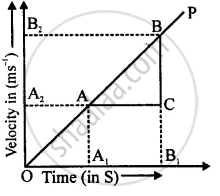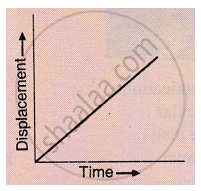Advertisements
Advertisements
प्रश्न
How can you find the following?
Acceleration from velocity – time graph.
उत्तर
Acceleration from velocity – time graph: Velocity – time graph for uniform motion in a straight line (OP) inclined to the time axis.

Take any two points A and B on this graph. From A and B draw perpendicular on the time axis as well as velocity axis in such a way that
OA1 = t1, OB1 = t2, OA2 = v1 and OB2 = v2
Slope of v – t graph = `"BC"/"AC"`
= `("v"_2-"v"_1)/("t"_2-"t"_1)=(Δ"v")/(Δ"t")` = Acceleration of the body
So, by knowing the slope of velocity – time graph for uniform motion, we can find the acceleration of the body.
APPEARS IN
संबंधित प्रश्न
What conclusion can you draw about the velocity of a body from the displacement-time graph shown below :

A motorcycle moving with a speed of 5 m/s is subjected to an acceleration of 0.2 m/s2. Calculate the speed of the motorcycle after 10 seconds, and the distance travelled in this time.
Derive the formula s= `ut+1/2at^2` , where the symbols have usual meanings.
A train starting from stationary position and moving with uniform acceleration attains a speed of 36 km per hour in 10 minutes. Find its acceleration.
A bus increases its speed from 36 km/h to 72 km/h in 10 seconds. Its acceleration is :
Differentiate between uniform acceleration and variable acceleration.
The velocity-time graph of a body in motion is a straight line inclined to the time axis. The correct statement is ___________
For a uniformly retarded motion, the velocity-time graph is _____________
A stone thrown vertically upwards takes 3 s to attain maximum height. Calculate
- initial velocity of the stone
- maximum height attained by the stone. (Take g = 9.8 ms−2)
When will you say a body is at uniform acceleration?
